Calmodulin-Like Protein 5 (CALML5) Expression in Squamous Cell Carcinoma of Esophagus and Oropharynx
- PMID: 40535470
- PMCID: PMC12173638
- DOI: 10.1267/ahc.24-00064
Calmodulin-Like Protein 5 (CALML5) Expression in Squamous Cell Carcinoma of Esophagus and Oropharynx
Abstract
Squamous cell carcinoma (SCC), a common malignancy affecting the skin, vagina, uterine cervix, anus, larynx, and upper digestive tract, is characterized by significant disruption of cell-cell adhesion in stratified squamous epithelium during tumorigenesis, progression, and metastasis. CALML5, a stratified epithelial-specific protein linked to desmosomal junctions, plays a key role in cell adhesion and is notably downregulated in human papillomavirus (HPV)-associated cervical SCC. Esophageal and pharyngeal cancers, commonly with a squamous cell phenotype, have distinct etiologies: oropharyngeal carcinoma is strongly associated with HPV, whereas esophageal carcinoma is linked to environmental factors such as smoking, alcohol, and diet. To investigate the role of CALML5 in these cancers, we performed immunohistochemical analyses on clinical samples and explored its regulatory mechanisms using in vitro studies with human esophageal SCC cell lines. Our findings revealed that CALML5 expression is suppressed in early-stage esophageal SCC but reactivated at invasive sites in well to moderately differentiated SCC undergoing keratinization. In specialized SCC with sarcomatoid component, CALML5 reactivation occurred alongside aberrant KLF4 expression, highlighting its context-dependent role in tumor progression. Conversely, while HPV-unrelated oropharyngeal SCC exhibited patterns similar to esophageal SCC, HPV-related oropharyngeal SCC consistently showed suppressed CALML5 expression due to impaired KLF4 nuclear translocation. These results suggest that CALML5 functions as a tumor suppressor in HPV-associated cervical SCC but may be reactivated in non-HPV-associated invasive SCC, emphasizing its complex role in SCC pathogenesis and the need for careful interpretation of its expression in clinical contexts.
Keywords: Calmodulin-Like Protein 5; human papillomavirus; immunohistochemistry; squamous cell carcinoma; upper alimentary tract.
2025 The Japan Society of Histochemistry and Cytochemistry.
Conflict of interest statement
VThe authors have no conflicts of interest.
Figures
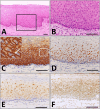
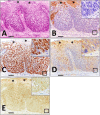
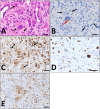
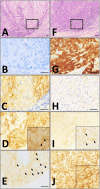
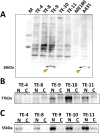
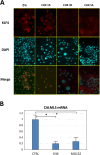
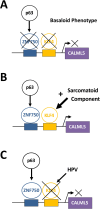
Similar articles
-
Single-Cell RNA Profiling of Ocular Adnexal Sebaceous Carcinoma Reveals a Complex Tumor Microenvironment and Identifies New Biomarkers.Am J Ophthalmol. 2025 Feb;270:8-18. doi: 10.1016/j.ajo.2024.10.001. Epub 2024 Oct 10. Am J Ophthalmol. 2025. PMID: 39393421
-
Targeting Drp1 inhibits ESCC progression via the ROS-PGC1-α-Nrf1/2 pathway.J Transl Med. 2025 Jun 17;23(1):674. doi: 10.1186/s12967-025-06697-8. J Transl Med. 2025. PMID: 40528181 Free PMC article.
-
Distinct Patterns of GLUT1 Expression in Human Papillomavirus Associated and Human Papillomavirus Independent Vulvar Intraepithelial Neoplasia and Squamous Cell Carcinoma.Mod Pathol. 2025 Jul 3;38(11):100836. doi: 10.1016/j.modpat.2025.100836. Online ahead of print. Mod Pathol. 2025. PMID: 40614899
-
Lymphatic dissemination of HPV-positive oropharyngeal squamous cell carcinoma: underlying mechanisms and treatment innovations.Front Immunol. 2025 Jun 2;16:1601572. doi: 10.3389/fimmu.2025.1601572. eCollection 2025. Front Immunol. 2025. PMID: 40529367 Free PMC article. Review.
-
Assessing the comparative effects of interventions in COPD: a tutorial on network meta-analysis for clinicians.Respir Res. 2024 Dec 21;25(1):438. doi: 10.1186/s12931-024-03056-x. Respir Res. 2024. PMID: 39709425 Free PMC article. Review.
References
-
- Babini, E., Bertini, I., Capozzi, F., Chirivino, E. and Luchinat, C. (2006) A structural and dynamic characterization of the EF-hand protein CLSP. Structure 14; 1029–1038. - PubMed
-
- Bagnardi, V., Rota, M., Botteri, E., Tramacere, I., Islami, F., Fedirko, V., et al. (2013) Light alcohol drinking and cancer: a meta-analysis. Ann. Oncol. 24; 301–308. - PubMed
LinkOut - more resources
Full Text Sources
Research Materials

